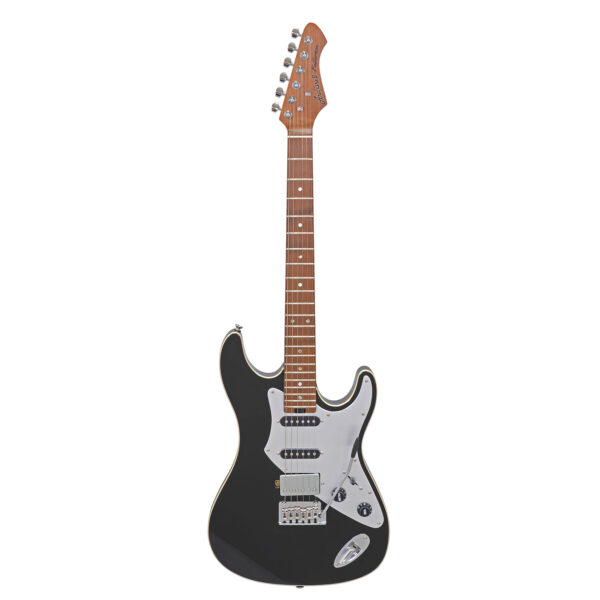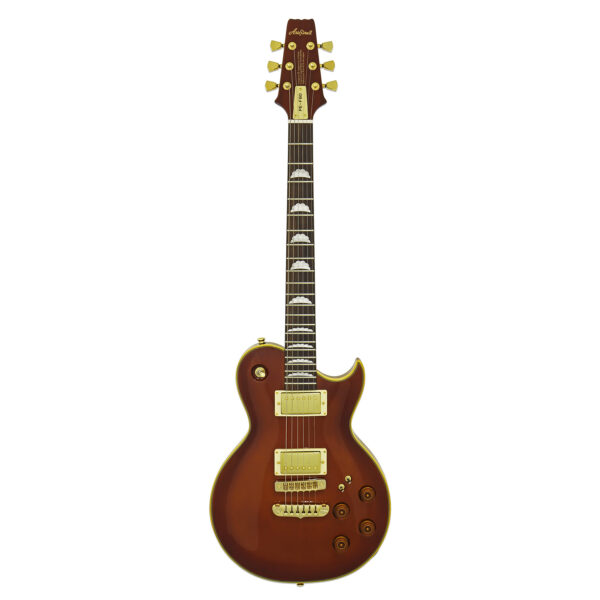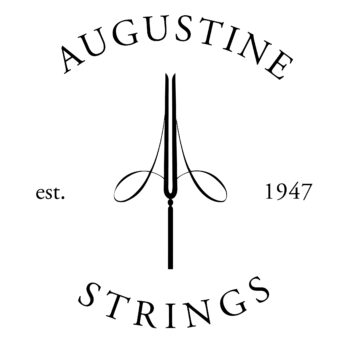HISTORY OF ARIA GUITARS

Shiro Arai

Arai & Co., Inc.

Catalogue 1956
“It all started with the classical guitar, when I heard my friend played a piece by Bach” says Shiro Arai
With the arrival of rock ’n’ roll, Arai also began importing electric and steel string acoustic guitars from overseas.
During the early Sixties, the company expanded into production of its own guitars, beginning with acoustic and hollowbody models in 1960, followed by the introduction of solidbody electrics in 1963, issued under the brand names of Aria (an anagram of Arai).
Soon the company began exporting guitars to various countries, including the United States. As demand grew, Aria contracted Matsumoku Industrial, a woodworking company based in Matsumoto, Nagano Prefecture.

60s Catalogue
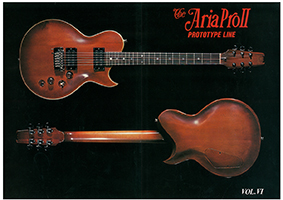
PE-1500
In the 70s, while Japan was enjoying an enormous acoustic guitar song boom as it was happening in the USA and some European countries, Aria guitars started to develop original new design electric guitars.
In 1975 “Aria Pro II” brand was launched. It was dedicated to electric guitar productions in order to bespeak a clear distinction with other acoustic and classical guitars which was being produced under the name of “Aria” brand, and it was named with all heart of that “PRO” for maintaining a professionalism, and “II” for being one step ahead.
In 1976, its first original model, the PE-1500 was released.
The PE-1500 was a well-received success. Further models followed, starting with the PE-800 in 1978 and the PE-600, PE-500 and PE-400 in respective order over the next few years. Each new model offered improvements, such as the materials used, functionality and decorative aspects such as bindings.
Aria Pro II PE guitars were soon seen with guitarists like Neal Schon of Journey, Andy Summers of the Police (notably in the Police’s 1978 performance of “Can’t Stand Losing You” and “Next to You” on England’s The Old Grey Whistle Test TV show) and Gerry Cott of the Boomtown Rats. Henrik Flyman, guitarist with Scandinavian metal band Evil Masquerade, is a life-long dedicated Aria Pro II PE player who has kept the model relevant in the new millennium.
“I got my PE-1500 back when guitars were supposed to be brightly colored and oddly shaped,” Flyman says.
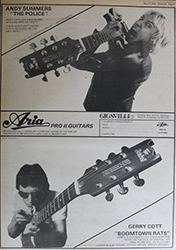
Andy Summers & Gerry Cott

PE-1000U “Limited in 1978”
Japanese Urushi lacquered
Shortly after the first Aria Pro II guitar model hit the market, the Aria Pro II SB (Super Bass) made its debut in the late Seventies.
The flagship SB-1000 quickly became a mainstay for players such as Cliff Burton (Metallica), John Taylor (Duran Duran) and Cronos (Venom). During the Eighties, Michael Anthony (Van Halen), Jack Bruce and Rudy Sarzo (Whitesnake) were often seen playing an Aria SB bass on stage.
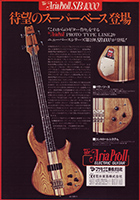
Catalogue 1978

Cliff Burton w/SB-1000

Rudy Sarzo w/ SB-RSZ

Jack Bruce w/ SB-1000
Between 1978 and 1982, the company produced the Aria Pro II Rev-Sound series models (RS-850, RS-750, RS-600 and others), which featured neck-thru-body construction with laminated multilayer maple and walnut necks and active electronics.

RS-1000Z
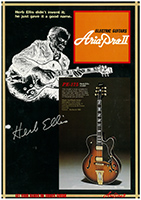
PE-175
American jazz great Herb Ellis’s model PE-175, an archtop electric guitar was released in 1979 and it was remained in production until the late Eighties.
During the early Eighties there were some additions of the Cardinal series (CS) and Thor Sound/Tri-Sound (TS) models, which offered bolt-on, set and neck-thru-body models. Demand for Super Strat guitars increased as heavy metal became more popular, and to respond the demand Aria Pro II RS Esprit was released in 1983, which was a much more streamlined version of the RS-850. The RS Esprit was briefly the guitar of choice for Yngwie Malmsteen during his stint with Alcatrazz from 1983 to 1984.
George Lynch briefly played the similar Aria Pro II RS Knight Warrior in 1984 and was photographed with the guitar on the back cover of Dokken’s Tooth and Nail.
“I never had an endorsement offered to me before,” Lynch says. “I was extremely excited about getting a guitar and being promoted through a guitar company. Aria offered me one electric and one acoustic guitar, so I picked what I thought was the most upscale and coolest looking guitar in a catalogue, along with whatever acoustic guitar they offered me. I used the Knight Warrior to play exactly one note which was a dive bomb at the end of some solo on ‘Tooth and Nail.’
The Aria acoustic, on the other hand, was used for all the acoustic work on that same record, including ‘Alone Again.’ To be honest, my interaction with the Aria Pro II was very limited and only for a short period of time while recording the album at Cherokee studios.”
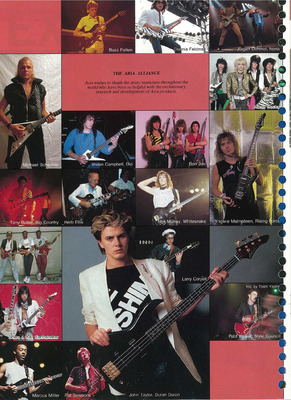
Catalogue 1985
Adoration of hard rock / heavy metal inspired designs expanded with the introduction of the V-shaped Aria Pro II XX, off-set shaped Aria Pro II ZZ and Aria Pro II Urchin series, also IGB (Integra) bass series whilst not abandoning its routes the semi-acoustic guitar models, FA and TA were also introduced.

Billy Gould w/ IGB-550
In the early 90s the MA series was launched to reinforce the PE and SB line-ups. MA series bodies are constructed with innovative crystal shaped carved top which current MAC series inherits.
Continuing its remarkable progress, Aria released the very unique concept of the SWB (electric upright bass) series to the world in 1992. The SWB range offers compact modern design and features the Fishman custom bridge Piezo pickup and active tone circuit.
Because the American instrumental guitar group the Ventures remained hugely popular in Japan ever since the entire band first toured there in 1964 (Bob Bogle and Don Wilson previously played in Japan in 1962, but as a duo) and kicked off a boom in guitar sales, Aria joined forces with the group in 1991 to offer the first Ventures signature model instruments made exclusively for the Japanese market. In 1999 Aria released a new upgraded version, and in 2001, 2002 and 2003 Aria introduced Ventures signature models.
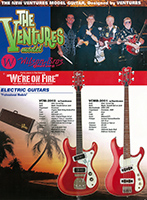
The Ventures
VCM-2001 & VCMB-2001
In 2013, Cliff Burton signature bass was first-ever produced with the authorization of the Cliff Burton family and Metallica. The bass was a replica of “SB-Black ‘n Gold I”, and it was successfully lanced at NAMM 2013 in the presence of Mr. Ray Burton the father of Cliff Burton. The current Metallica bassist Robert Trujillo often plays SB bass when performing the band’s Cliff Burton-era material.
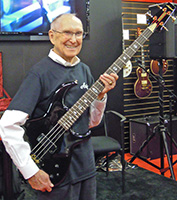
Ray Burton at NAMM 2013
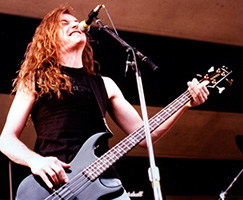
Cliff Burton

SB-BLACK N’ GOLD I




